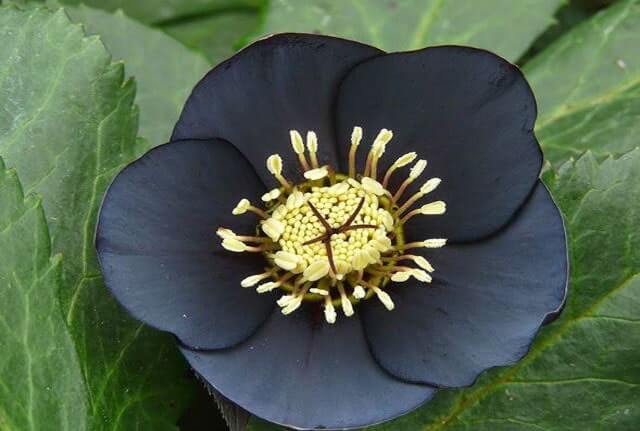You may have heard of the beauty of black diamonds, but have you ever explored the world of black flowers?
In this article, we’ll look at these unique blooms that, while not always truly black, exhibit captivating and deep colors.
With their rich hues, black flowers add a special theme to gardens and landscapes.
These flowers have a history that spans centuries, leaving an imprint on various aspects of human culture.
Join us as we explore black flowers’ names and pictures.
What Is So Special About Black Flowers
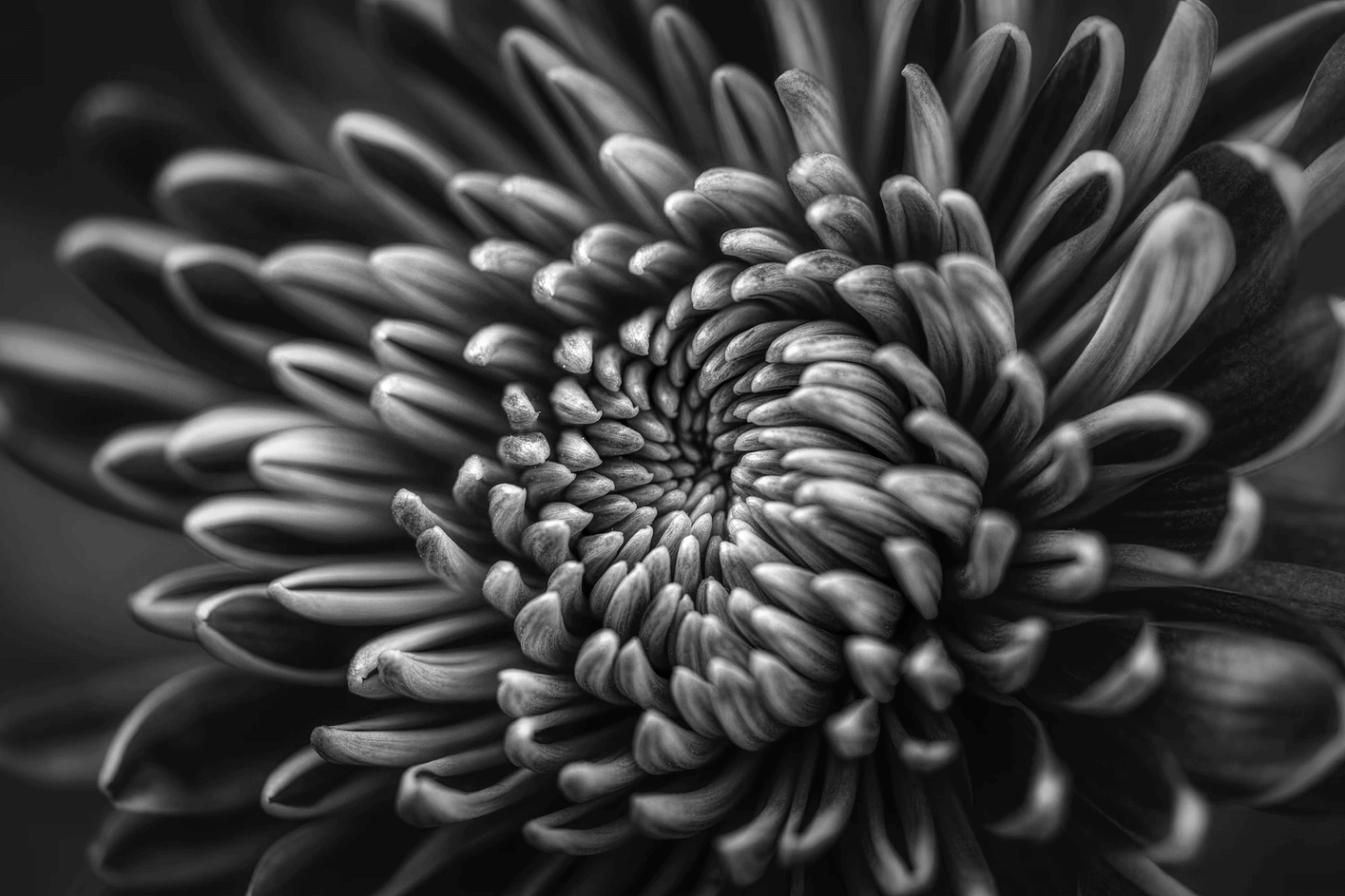
Black is more than the absence of light. It represents the unknown and something unique. Therefore, you will likely be impressed and amazed when you see a black flower.
If you ever go outside for a long walk, you will notice at least ten different species of black flowers. However, it is essential to note that truly black flowers are extremely rare.
Most flowers that appear black are very deep shades of other colors, such as purple or red, a phenomenon often due to the high concentration of anthocyanin pigments.
How to Grow Black Flowers?
If you have a garden or flower bed and want to know how to grow a beautiful patch of black flowers, follow these simple instructions:
- Place the plant or tree growing these flowers in a warm, sunny area. The warmth and Sunlight will encourage these plants/trees to grow and blossom beautiful black flowers.
- Make sure that the soil is pure topsoil. Plants and trees that black blossom flowers need this.
- Be sure to water regularly.
Types of Black Flowers and Their Names and Pictures
Now that you have some insight into black flowers and how to grow them, it is time to discuss the different black flower species and their names.
Also, it might interest you to learn that selective breeding has been used to enhance certain traits in plants, including darker pigmentation.
The term “genetic engineering” might suggest a modern, more direct manipulation of genes, which has not historically been the primary method.
If you were to walk into a virgin forest or meadow, you would find that it had no black flowers.
Humans have been able to breed black flowers by crossbreeding plants and trees that will blossom flowers with high anthocyanin chemicals.
Every flower produces this. It determines its overall pigment and hue. Anthocyanin tends to express itself (naturally) in three colors: red, purple, or blue.
Black flowers tend to have high levels of anthocyanin.
Now, it is time to discuss some black flower species more commonly found in forests, meadows, flower beds, gardens, and places with many flowers.
Pansy
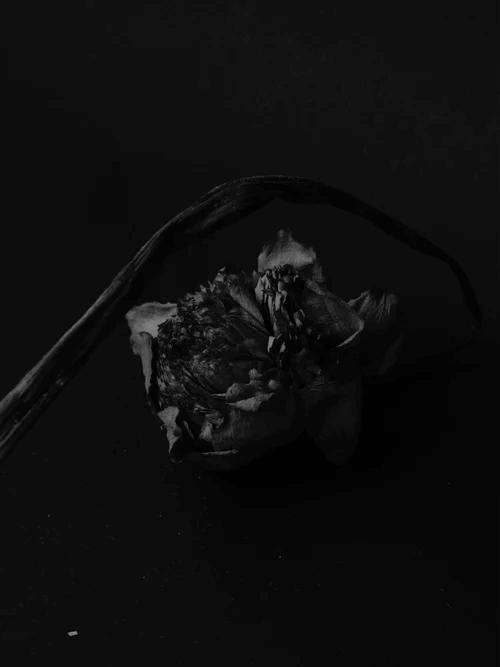
Okay, so while this black flower may not be completely black, it does look mysterious and beautiful. The black pansy has a creamy white center.
This only adds to its appeal. The black pansy’s petals are soft and as thin as writing paper. It’s important to understand that these pansies are not truly black but are deep purple or burgundy.
These nuances in color add to their unique appearance.
These black flowers are incredibly wonderful to view during the daytime or a full moon. You will then notice that the petals have a shiny hue to them.
The black pansy’s petals gleam during a full moon.
This flower blooms during the springtime.
Petunia
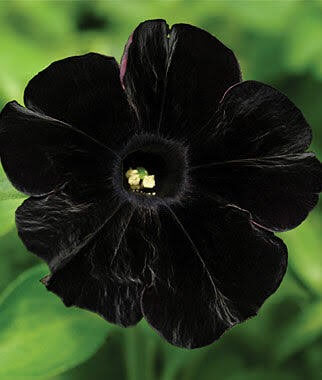
Flower lovers also refer to this species of black flower as a ‘black cat.’ Its nickname may be derived from its more rugged texture and look, resembling a black cat’s shiny fur.
By the way, this species of Petunia also shines and shimmers either during the night or day.
However, it’s worth noting that black petunias are typically very deep shades of purple or red rather than true black.
The black petunia comes from the Solanaceae family of flowers. Each plant will bloom many black flowers (they will resemble a thick bush in terms of arrangement) from the early spring until the late fall.
Petunias come in many different colors, ranging from purple to red. Therefore, black petunias are a rare and intriguing sight.
It has petals with a soft and creamy velvety texture.
Combined with its dark hue, this gives a hauntingly beautiful contrast and appearance against the green plant branches.
The three white clusters at its center are unique from other black flowers.
Tulip
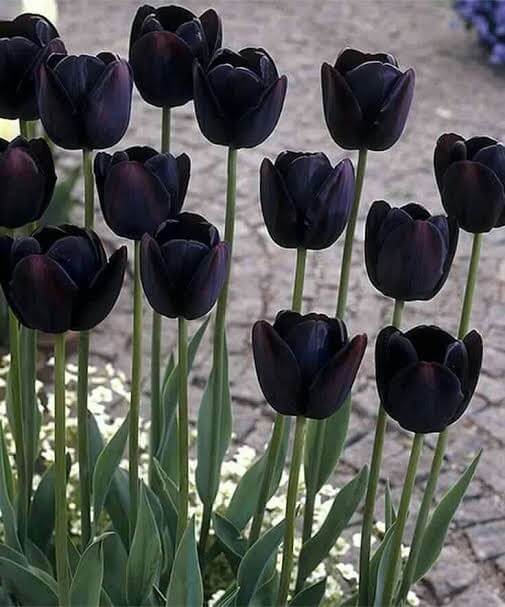
This species of black flower belongs to the Liliaceae family of flowers. They are beautiful flowers that bloom in the springtime.
They appear in April and last until May. Their purple hues and closely clustered petals give them a unique beauty that cannot be compared.
This is why horticulturalists categorize them among the world’s most beautiful flowers.
Remember, we often perceive black tulips as deep purple or maroon, contributing to their uniqueness and beauty.
People have historically associated the black tulip with love, good thoughts, good vibes, and forgiveness.
There are many species of black tulips. The one you will see most often is called the “Queen of the Night!”
However, it’s crucial to note that even the “Queen of the Night” tulip is not truly black but a very deep purple, adding to its allure and mystique.
Black Bearded Iris
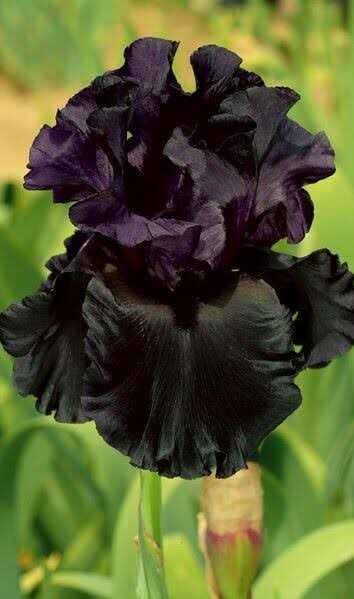
This black flower comes in many species. The black Iris looks great when planted with flowers of different colors since its very black color gives new character and definition to the differently colored flowers.
It’s important to remember, though, that what is often perceived as black in these irises is a very deep purple or dark maroon.
These are perennials, meaning they will remain dormant when the season changes but will start to bloom again when their flowering season returns.
Not only will they look nice in your garden, but they will also give off a wonderful fragrance.
Some species of very black-bearded irises are mentioned below:
- ‘Before the storm’ iris – this is the blackest of the black irises that currently exist. They are as black as night and rest on a longer stem. Horticulturalists love their pleasant smell, and so will you.
- ‘Men in Black’ iris – these flowers may have deep purple petals, but you could never tell this even if you saw them up close. Their color and hue are misleading. These ‘Men in Black” iris flowers look deceptively black even when viewed up close and on the plant! There is an exciting feature that you will notice about these flowers immediately. This makes them unique and catches the eye – they have mustard-yellow-colored beards in the middle.
- “Winesap” Reblooming bearded Iris – this variant of the Iris does not grow black flowers at all, even though it belongs to a family of black blooming flowers. If you were to grow this variant in your garden, you would be pleasantly amazed to see flowers that were the color of dark red wine blooming every year in the springtime. You would also notice that the area where these flowers grew would smell like sweet perfume – these flowers give off a great fragrance.
- “Old Black Magic’ Bearded Iris – this variant of black-bearded Iris blooms every spring. It grows on leaves that are shaped like swords. It has a very dark plum, almost black, color. You will love its delightful fragrance and the air of mystique that it will give your garden. This variant of black-bearded iris can also bloom purple to purplish-black flowers.
Black Dahlia
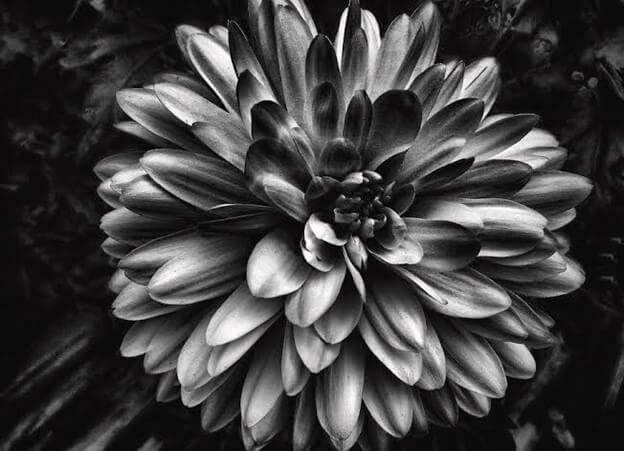
Okay, so these flowers are clever imposters. They are not black flowers. These black dahlias tend to bloom into dark red and burgundy-colored flowers.
The thing is that they are such a dark color of red that they look black, especially at night. This unique coloration contributes to their mysterious and intriguing appearance.
If you have a black dahlia plant in your garden, you have noticed that this species of black flowers grows large clusters of flowers in beautiful, engaging, and intricate patterns. Each flower is enormous!
These black dahlias (along with their lighter and more colorful cousins) are members of the Asteraceae family, meaning they belong to families similar to asters, chrysanthemums, and daisies.
If you plant this type of black flower in your garden, you will find that it will bloom every summer. They will start to wither in the late fall.
There are two species of black dahlias: Arabian Night and Chat Noir.
- Arabian Night – this type of black dahlia has two dark petals with each flower – hence the description ‘double dark flower!’ These black flowers can grow up to 4 inches wide. What will catch your eye about these ‘black flowers’ is their stunning and haunting beauty and the contrast of dark red and black petals they grow. These dark red flowers make for a fabulous bouquet for a special occasion because they will seem deceptively black to the person you give it to (the bouquet).
- Chat Noir – this sub-species of black dahlia blooms burgundy-colored petals. They are so dark that they look deceptively black even when viewed a few inches away. You will immediately notice two things about this sub-species of black flowers: they are huge flowers that can grow up to 8 inches across and have pointy petals. If you were to feel these petals, you would be surprised by their soft, velvety feel.
‘Odessa’ and ‘Black Forest’ Calla Lily (Zantedeschia)
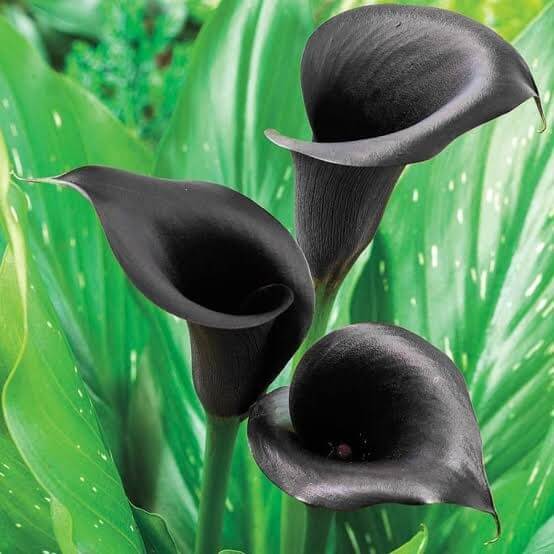
These species of lilies belong to the Zantedeschia family. There are two sub-species of these types of black flowers, the Odessa and the Black Forest.
- Odessa – this sub-species of lily is an exciting type of black flower. Its dark purple petals that look deceptively black give it this distinction. If you grow the Odessa lily in your garden, you will notice that the petals make a beautiful contrast to the leaves shaped by arrows that they blossom from. You may find that the leaves are freckled with white spots that give them fantastic beauty.
- Black Forest – this sub-species of lily grows black flowers with petals shaped like funnels. The petals may have a deep purple color, but you would never notice that you are not a horticulturist or a botanist. These flowers would look black to you!
You can grow these sub-species of lily in containers on your windowsill. Just ensure you water it enough and expose it to Sunlight regularly.
People who live in apartments and other housing types that do not have gardens love the Black Forest lily because of its fantastic ability to grow in any environment with adequate Sunlight.
‘Green Wizard’ Coneflower
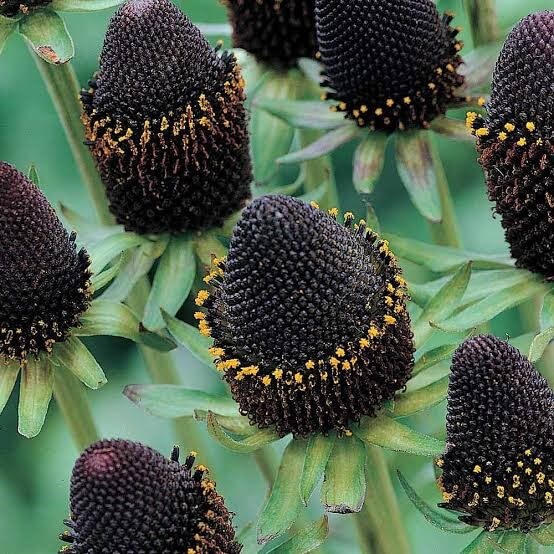
This species of black flower is officially called the Rudbeckia Occidentalis.
People who grow this type of black flower in their gardens or nurseries call it the Western Coneflower. You will love this type of black flower if you plant it in your garden.
One exciting thing you will notice about these flowers immediately is that they grow into flowers shaped like upside-down strawberries.
They may grow clusters of evenly interspersed purplish-brown petals, but they look black even when viewed up close and in Sunlight.
There are many types of coneflowers. Two more popular ones are the ‘Green Wizard’ and the ‘Black Beauty.’
One thing you will notice about these coneflowers is their clusters of yellow pollen near their ends.
This is unique since most flowers tend to have pollen clusters in the center where the petals meet.
Bat Orchid
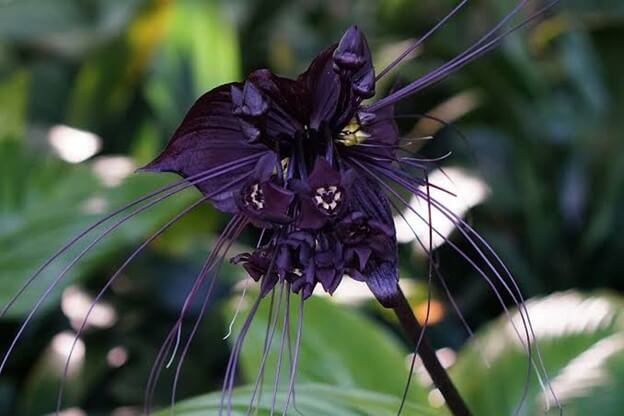
If you live in Thailand, Vietnam, or any other Southeast Asian country, including India, you’ve probably seen or grown the Bat Orchid.
This species of black flower is unique, even for black flowers. It grows closed buds that hang up and down from the central flat flower petals.
The bat orchid gets its name because it looks like a flying bat.
Its flat petals can grow up to 12 inches wide. Its drooping bat-like petals can grow at 28 inches.
You will notice that this species of black flowers does grow black petals.
‘Black Charm’ Asiatic Lily
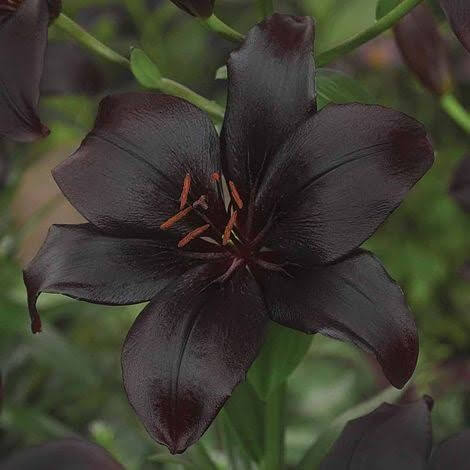
This type of lily belongs to the Lilium and Liliacaea families. It is known for its hauntingly beautiful black flowers.
You will notice that these tall flowers smell lovely and are shaped like trumpets.
The Black Charm may bloom petals that are dark burgundy. But you would never notice that unless you were a seasoned botanist or horticulturalist.
You will notice that every part of the flower looks deceptively black. Therefore, they make a great gift when given as a bouquet at a funeral or a special event/occasion.
You will notice that this sub-species of black flowers will add real flair to your garden and give it charm and personality.
‘New York Night’ Hellebore
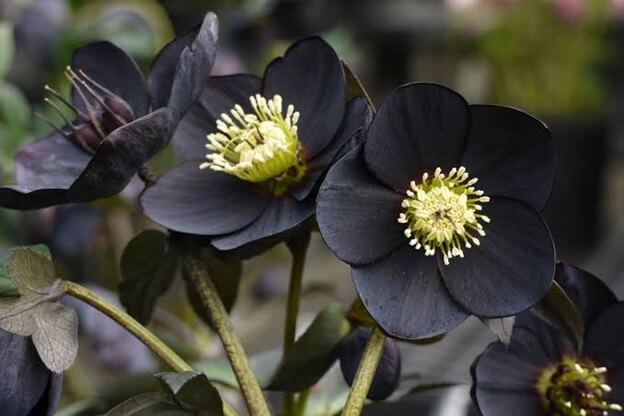
One exciting thing about its black flowers is that they blossom only in the spring. The ‘New York Night’ Hellebore belongs to the Ranunculaceae family.
It has a stamen and pestle that are creamy-yellow. When set against its jet-black petals, it will be a real masterpiece in your garden.
Each flower has five petals that can grow up to three inches wide. While they are referred to as black, these petals are a very deep purple, which provides a stunning contrast against the creamy-yellow center.
‘Blacknight’ Holly Hock (Alcae Rosa)
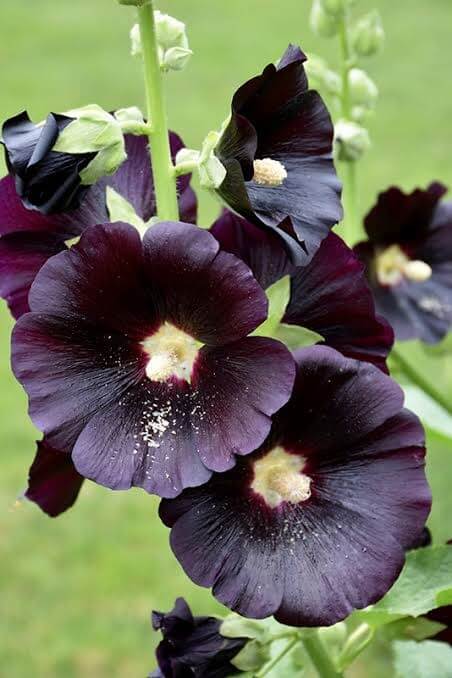
This type of black flower belongs to the Alcea Rosa family. It blossoms every spring and withers during late summer.
If you grow the black sub-species of this flower in your nursery or garden, you will immediately notice that its petals are black and shaped like funnels.
The centers pop with bright and vibrant colors. This sub-species blooms petal is a dark purple-black, but to the untrained eye, they appear simply as black.
The ‘Nigra’ sub-species of Holly Hock is similar, with deep black petals freckled with purple spots and bright yellow or white cores.
‘Black Baccara’ Rose
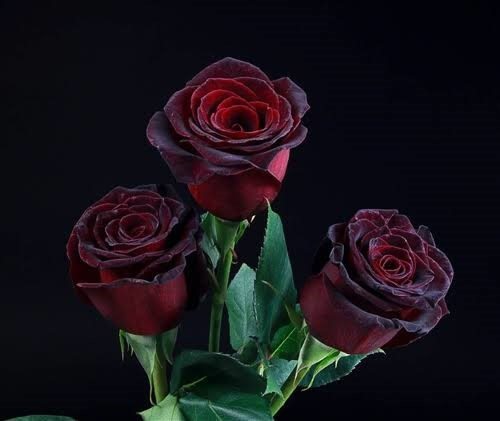
If you traveled the world regularly, you would find this species of black flower in almost every place you visited.
This sub-species of rose blossoms have very dark red petals that look black to the untrained eye.
If you touched these petals, you would notice their velvet-like texture and soft feel. Its petals are shaped like a classic rose, making it an exciting gift for your girlfriend on Valentine’s Day.
It’s important to note that the ‘Black Baccara’ rose is not truly black but a deep red, creating a dramatic and striking appearance.
‘Black Widow’ Cranesbill Geranium
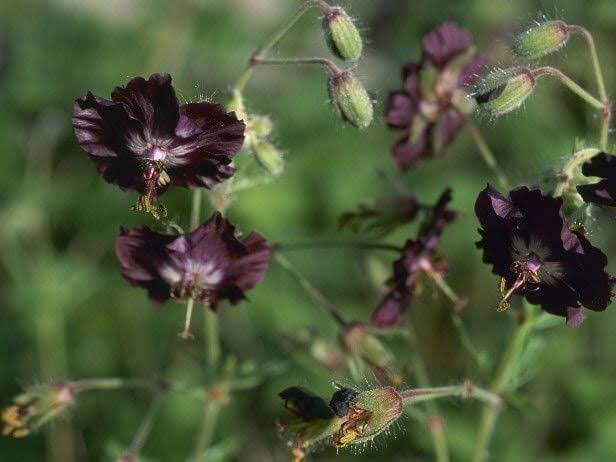
This black flower belongs to the Geranium Phaeum family. Its official name is the Mourning Widow.
If you were to grow this black flower species in your garden or nursery, you would immediately notice that its petals had a purplish-black color.
The petals feel like soft crepe paper when touched. Its stems are covered with hairy fluff.
This is what puts this species of black flower in a class of its own. One unique feature is the tendency of its wrinkled petals to grow backward.
What Black Flowers Symbolize
Black flowers have been used in literature since the beginning of civilization. A simple reference to the great 19th-century American writer Edgar Allen Poe’s work proves this.
Black flowers, especially the black rose, have had a special place in human civilization for over seven thousand years.
Historically, they symbolize many things, including relationship commitment, rebirth, or saying a final “goodbye” to something living.
It’s important to note that while these flowers appear black, they are often deep shades of other colors, which adds to their mystique and symbolism.
1. Black Flowers Have a Special Place in Romance Novels
Black roses have appeared in romance novels for many centuries.
If you read enough romance novels published throughout the ages, you would quickly learn that the black rose symbolized (and continues to symbolize) the sudden sadness that can appear in a relationship.
2. Black Flowers Appear in Tarot Cards Sets
Everyone loves seeing an astrologist, whether for fun or to learn what the future has in store for them seriously.
Black flowers, especially black roses, tend to have darker connotations when placed in Tarot card sets.
If you were ever to have an astrologer pull out a card with a black rose, or if you were ever to choose this card, you may want to worry.
Selecting this type of card would mean revenge, lousy luck and events, immortality, someone disrespecting you, or a state of despair.
Therefore, you may want to throw salt over your shoulder for a streak of good luck in this instance.
3. Black Flowers Appear When Chaos Is Present
Murphy’s Law states, “Whatever can go wrong will go wrong.” This refers to the fact that chaos is always present in life. The chaos theory proves this.
Indeed, Adolf Hitler used more than just the swastika to represent his Nazi Party which reigned in more than six years of terror and mayhem in Europe.
He also relied on the black rose to tell his followers (subconsciously) to trust him because ‘all was fine, and the Nazis would triumph against the European traitors!’
4. Black Flowers Have a Special Place in Japanese Cartoons
Well, the cartoons that come out of Japan are called anime. They are unique, and so is much of their symbolism.
If you have played anime games, one thing you will notice is the heavy reliance on black flowers.
The flowers represent the less-than-desirable qualities of a character’s personality. It can also represent a dark (and nasty) soul.
But black roses symbolize more than just this. They can also symbolize certain negative character traits and qualities like ignorance, evil thoughts and intentions, and selfish interests.
5. Black Flowers Make Music Very Interesting
Black flowers have a special place in the music industry. They represent the dark realities of life.
They can also represent the dual and negative nature and/or qualities of something. A good example is the political situation in most nations.
6. Black Flowers Are Special
If you were to walk through countless meadows, you would have to do a lot of walking before you found plants that bloomed black flowers.
They are that rare. That said, many different species of black flowers exist in this world.
The haunting nature of these flowers, coupled with their innate dark mystic beauty, have given them a historical significance in every aspect of human civilization since the beginning of civilization.
Conclusion
In summary, black flowers, with their dark beauty, hold a special place in our hearts and culture.
While they may not always be truly black, their deep and rich colors add to their charm.
They symbolize various emotions and concepts, from love and sadness in literature to darker tarot cards and music themes.
Whether you’re a gardener or appreciate the beauty of nature, black flowers are a unique addition to any environment.
Their rarity and intense colors make them stand out, reminding us of the diverse expressions of nature.
So, next time you come across a black flower, remember the stories and symbolism it carries within itself.

